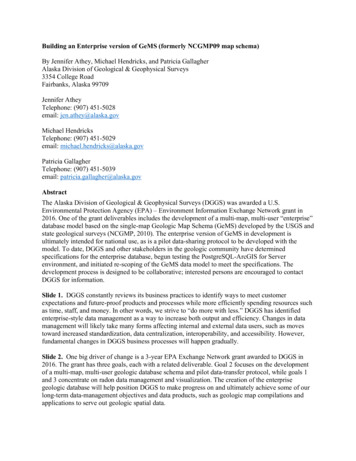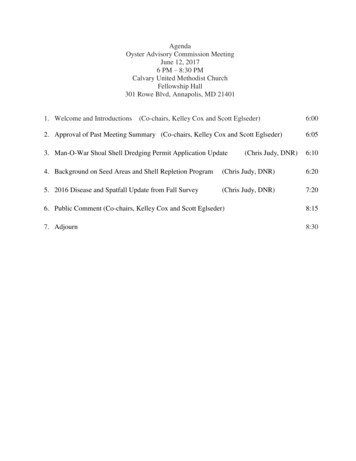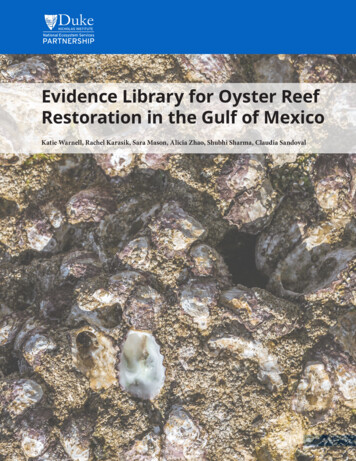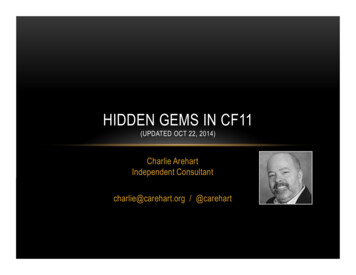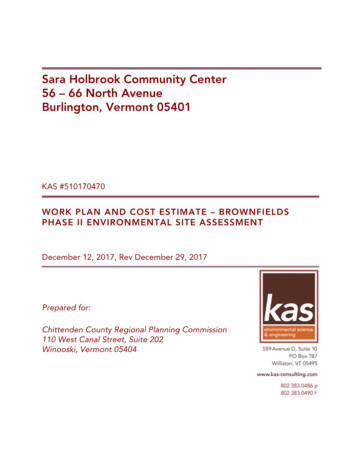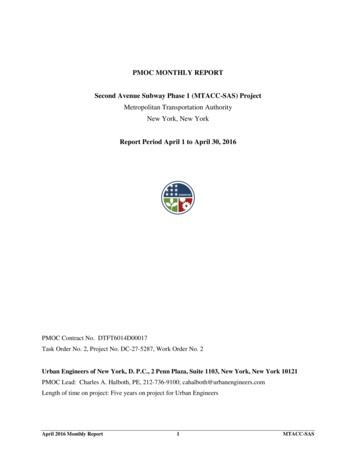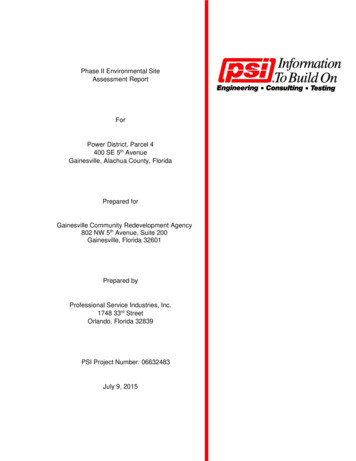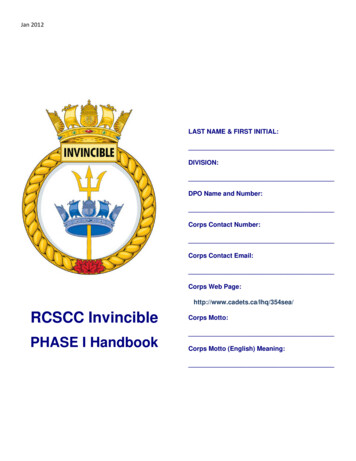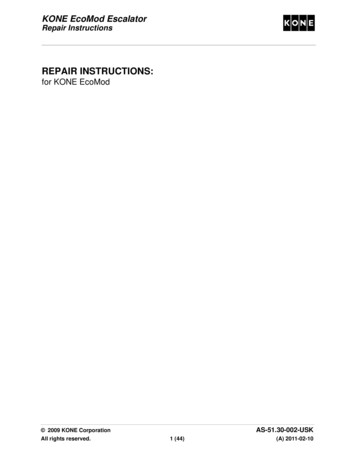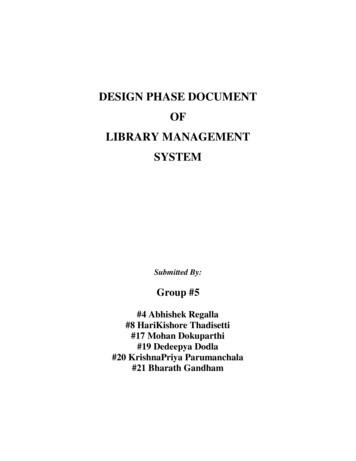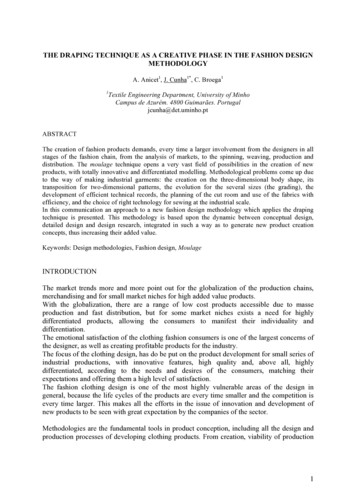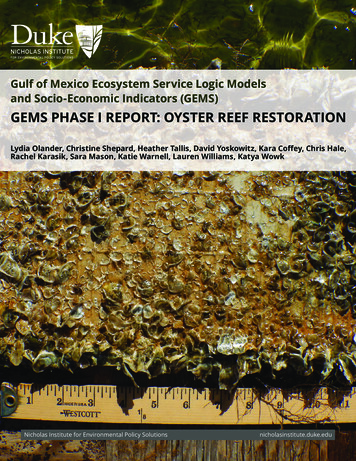
Transcription
NICHOLAS INSTITUTEFOR ENVIRONMENTAL POLICY SOLUTIONSGulf of Mexico Ecosystem Service Logic Modelsand Socio-Economic Indicators (GEMS)GEMS PHASE I REPORT: OYSTER REEF RESTORATIONLydia Olander, Christine Shepard, Heather Tallis, David Yoskowitz, Kara Coffey, Chris Hale,Rachel Karasik, Sara Mason, Katie Warnell, Lauren Williams, Katya WowkNicholas Institute for Environmental Policy Solutionsnicholasinstitute.duke.edu
Gulf of Mexico Ecosystem Service Logic Modelsand Socio-Economic Indicators (GEMS)GEMS PHASE I REPORT: OYSTER REEF RESTORATIONProject BackgroundCONTENTSProject Background2Phase I Process3Focal Estuaries4Oyster Reef Restoration Techniques4Oyster Reef Restoration Ecosystem ServiceLogic Model7Estuary-Specific Oyster Reef RestorationESLMs9Socioeconomic Metrics for Oyster ReefRestoration17Next Steps20Billions of dollars will be spent on large-scalerestoration of Gulf ecosystems over the comingdecades, but there is no shared platform to guideassessment and reporting of restoration progressand effectiveness for the broad set of environmental,social, and economic goals shared by the manyinstitutions working in the Gulf. The diversity of thesegoals—including habitat restoration, water qualityimprovement, marine resource protection, communityresilience, and economic revitalization—meansthat a variety of metrics are needed to fully evaluatethe effectiveness of restoration projects. A set ofcommon models and metrics relevant across projects,programs, and locations can facilitate effectiveproject planning and evaluation. While there areexisting efforts to collate and standardize ecologicaland biophysical metrics for Gulf restoration projects(GOMA Monitoring Community of Practice; NRDAMonitoring and Adaptive Management Manual),there is no current effort to do the same for thesocial, economic, and human well-being outcomes ofrestoration. This project aims to do that.The GEMS (Gulf of Mexico Ecosystem Service LogicModels and Socio-Economic Indicators) project aimsto advance standardized metrics of restoration successby developing ecosystem service logic models (ESLMs)with stakeholders from the five Gulf states, relevantfederal agencies, and technical experts. ESLMs tracethe effects of restoration strategies as they influenceecological and social systems to create outcomes thatare important to people. The use of logic models isrecommended by the National Academies of Science asbest practice for monitoring plan design; these modelscan provide a practical and transferable approach formeasuring success at different scales.
Numerous strategies for coastal restoration exist (for example, see the numerous project typesincluded in the RESTORE Planning Framework), and there are many places along the Gulf coastwhere restoration can be implemented. ESLMs are helpful for comparing across restorationstrategies and locations to match likely restoration outcomes with stakeholder goals. In addition,evidence that accompanies these models can be used to clarify uncertainties that need to beconsidered and to identify critical research gaps.The GEMS team will develop ESLMs and metrics for a wide range of coastal restorationapproaches over the course of the project. This report presents the results of the first phase of theGEMS project, which focused on oyster reef restoration.Phase I ProcessWe selected specific restoration approaches to focus on for each phase of this project to groundour efforts in commonly used, widely applicable restoration project types. With input fromthe advisory council (Appendix I), oyster reef restoration was selected as the focal restorationapproach for the first phase of the GEMS project for several reasons. Oyster harvesting is asignificant economic and cultural activity in the Gulf region, and oyster reefs are a key partof healthy coastal ecosystems. Recent widespread declines in oyster populations have spurredsubstantial investment in oyster reef restoration and oyster population enhancement projectsacross the Gulf of Mexico.Our first step was to develop a general oyster reef restoration ESLM based on literature andconversations with restoration experts. We also created restoration technique specific models(see next section for details). Then, a series of local workshops brought together restorationpractitioners and stakeholders in five focal estuaries (one in each Gulf coast state; see detailsbelow) to discuss what oyster reef restoration looks like in that estuary, identify the outcomesof oyster reef restoration that are most important in the local context, and develop an initiallist of socioeconomic metrics that could be used to measure those outcomes. Local workshopparticipant selection was guided by the advisory council, and a local lead for each focal estuaryhelped with participant outreach and workshop preparation. Information from the localworkshops was used to further refine the oyster reef restoration ESLM and to start a metricsassessment process. Metrics suggested at local workshops were integrated with additional metricsfrom the literature and standard criteria were applied to identify the most useful metrics. Next,a regional workshop including representatives from the local workshops, experts on oysterreef restoration and socioeconomic indicators, and members of Gulf coast restoration fundingorganizations focused on testing and refining the proposed metrics. (See Appendix I for lists ofworkshop participants.)Key outputs from phase I of the GEMS project included in this report are: General and technique-specific oyster reef restoration ESLMs Estuary-specific results (outcomes, key species, and external factors) Socioeconomic metrics for oyster reef restoration in the Gulf of MexicoNicholas Institute for Environmental Policy Solutions, Duke University 3
Focal EstuariesFive focal estuaries, one in each Gulf coast state, were selected with input from the advisorycouncil to capture the range of ecological and social conditions as well as data availability foundacross the region. Estuaries selected included: Galveston Bay, TX; Chandeleur-Breton Sounds,LA; Back Bay of Biloxi, MS; Mobile Bay, AL; and Charlotte Harbor, FL (for more informationon these estuaries, see fact sheets used at local workshops). We hosted a workshop in each ofthese locations to get feedback and insight from oyster restoration researchers and practitionersworking in various contexts across the Gulf.Figure 1. Focal EstuariesOyster Reef Restoration TechniquesOyster reef restoration techniques vary in the process and materials used, environmentalconditions required, social and legal contexts, and expected outcomes (shoreline stabilization,oyster harvest, water quality improvement, etc.). Six different oyster reef restoration techniquesare widely used across the Gulf of Mexico; techniques used vary by estuary (or locally).Nicholas Institute for Environmental Policy Solutions, Duke University 4
Table 1. Oyster Reef Restoration TechniquesStructurally simple, subtidal, intensively harvestedThis technique consists of placing cultch material (usually oyster shells, relic shells,crushed limestone, or crushed concrete), either loose or contained, so that theresulting structure lies flat along the estuary/ocean floor. This technique has beenwidely used throughout the Gulf for the primary purpose of providing oysters forharvest.Example project: Louisiana Oyster Cultch ProjectStructurally complex, subtidal, intensively harvestedLarge, durable structures (e.g., oyster balls, precast concrete structures, and limestone structures) are placed in subtidal areas to create substrate to which oysterscan attach. The resulting oyster reef has a significant vertical component, providesa more complex structure which oysters (of varying ages) and other aquatic organisms can use for habitat, and is less likely to be buried by sediment or degraded bywaves than the simpler structures in the previous technique.Example project: Galveston Bay Sustainable Oyster Reef RestorationStructurally complex, subtidal, not intensively harvestedThis technique is identical to the previous one, except that intensive harvesting(dredging or intensive tonging) is not permitted.Example project: Half Moon ReefStructurally complex, intertidal, not intensively harvestedLarge, durable structures (e.g., oyster balls, precast concrete structures, rocks,limestone structures) are placed in intertidal areas to create substrate to whichoysters can attach. Projects using this technique are often called “living shoreline”projects, as they are intended to protect shorelines from erosion by stabilizing sediment and attenuating waves as they approach the shoreline.Example project: Restoring Living Shorelines and Reefs in Mississippi EstuariesProtection or enhancement of existing oyster reefThese projects focus on the protection of an existing oyster reef from intensiveharvest (dredging), with or without reef enhancement (via seeding or placing oysters in existing reef area). Protected reefs could still allow low-impact harvestingmethods (tonging or hand collection) that do not threaten the reef structure orlong-term viability of the oyster populations. The objective of these projects is tosupport a sustainable oyster population, allow the reef to develop structurally overa long period, and possibly to create a source of oyster larvae to nearby reefs.Example project: Oyster Reserve Establishment in Mississippi SoundAquaculture: intertidal or subtidal, intensively harvestedOyster aquaculture projects of varying methods, including all bottom and off-bottom techniques. These projects encompass both intertidal and subtidal projects,and are considered to be intensively harvested, since the primary goal of oysterfarming is harvest and consumption.Example project: Alabama Oyster AquacultureNicholas Institute for Environmental Policy Solutions, Duke University 5
Participants in the local workshops identified the techniques used in each focal estuary:Table 2. Techniques Used in Each Focal EstuarySimple subtidal, vestedComplexsubtidal, NOTintensivelyharvestedComplex intertidal, NOTintensivelyharvestedProtectionand enhancement of existing reefCharlotteHarbor, FL Back Bay ofBiloxi, MS Mobile Bay,AL GalvestonBay, TX Chandeleur& BretonSounds, LA Oysteraquaculture Local workshop participants also discussed what drives the use of certain techniques, andprevents the use of other techniques, in each focal estuary. Their discussions are summarizedbelow:Charlotte Harbor, FL: Because there is currently no oyster harvesting allowed in this estuarydue to human health concerns linked to water quality, the techniques that include intensiveharvesting, including aquaculture, are not implemented here. In general, projects in this areatend to be small and done in intertidal areas (for protection of adjacent habitat types). There isinstitutional resistance to subtidal projects because they are more expensive than intertidal ones,and harvest restrictions due to water quality issues limit the benefits of many subtidal projects.Back Bay of Biloxi, MS: Commercial harvest of any type is prohibited in this estuary by state law,and recreational oyster harvest is not currently allowed due to health concerns, so the restorationtechniques involving intensive harvest or aquaculture are not implemented in Back Bay of Biloxi.Mobile Bay, AL: All six of the techniques are currently used or planned for use in this estuary.Placing simple substrate in subtidal areas with intensive harvest and placing complex substratein intertidal areas without intensive harvest are the most common. There are some complexsubstrate, subtidal projects planned. Oyster farming and aquaculture activity is growing in thearea and is a source of local pride and identity.Galveston Bay, TX: All of the restoration techniques except aquaculture are currentlyimplemented in this estuary. Placing simple substrate in intensively harvested subtidal areas ismost common and is done in both public oyster areas and on private leases (by the leaseholders).The Galveston Bay Foundation does many intertidal shoreline protection projects aimed atprotecting other habitats (e.g., marsh). There are some complex substrate subtidal projects aimedNicholas Institute for Environmental Policy Solutions, Duke University 6
at promoting ecosystem services, but there is always pressure to open projects to harvest. Aboutone-third of the bay is closed to harvest due to water quality issues, and some small, ecologicallysensitive areas, such as Christmas Bay, have been recently closed to intensive harvest. Whileoyster aquaculture is not currently used here, it is being discussed as a potential future option toreduce harvest pressure on oyster reefs.Chandeleur & Breton Sounds, LA: The only oyster restoration techniques used here involveplacing simple substrate in intensively harvested subtidal areas and three-dimensional, intertidal“living shoreline” projects. The state uses simple, two-dimensional substrate to provideharvestable oysters, and the intertidal (shoreline or habitat protection) projects are done byorganizations like The Nature Conservancy and the Coalition to Restore Coastal Louisiana. Therehave been a few very small demonstration projects placing complex substrate in subtidal areas,but these are unlikely to be scaled up because there is no large-scale oyster reef restoration of thistype included in the Louisiana Coastal Protection and Restoration Authority master plan. Thereare no protected oyster reefs in this area, and there is currently no aquaculture, although thereare ongoing efforts to obtain funding for it.Oyster Reef Restoration Ecosystem Service Logic ModelThe general ESLM was developed through a multistep process with input from oyster restorationexperts and local stakeholders as well as through a literature review. Information about eachof the links in the model is summarized in an evidence library, a structured way to collect andassess the evidence supporting each relationship represented in the model. The evidence librarycan be used to highlight gaps in our understanding of how oyster reef restoration affects thebiophysical and social systems and guide monitoring efforts to address these uncertainties.This is a general ESLM for oyster reef restoration. It is not tied to any one of the six restorationtechniques; rather, it represents all of the outcomes from those techniques that are dominant—large, tightly linked to oyster reef restoration, and important to the local community. The modelshows the cascade of changes that restoration (dark blue box) causes in the biophysical and socialsystems (gray boxes), leading to effects on commonly measured ecological components (greenboxes), human activity outcomes (light blue boxes), and socioeconomic outcomes (yellow boxes).Downloadable pdf and editable versions of the general ESLM, as well as specific versions of theESLM for each oyster reef restoration technique, are available on the GEMS website.Nicholas Institute for Environmental Policy Solutions, Duke University 7
Figure 2. General Ecosystem Service Logic Model for Oyster Reef RestorationNicholas Institute for Environmental Policy Solutions, Duke University 8
In the ESLM, pathways consist of links that connect the intervention (left) to a socioeconomicoutcome (right). Major pathways are those where socioeconomic outcomes are tightly linked tooyster reef restoration (ORR) (i.e. there is a possibility that the outcome would show a noticeablechange given an ORR project). Each link in a major pathway has a moderate to high strength ofevidence rating, is considered attributable to ORR (or has few “Other Factors”), and is consideredsignificant based on the evidence and stakeholder input. We highlight five major pathwayslinking the intervention to the following outcomes in Figure 3, below: Adjacent habitat (which can have a range of additional outcomes and can be exploredthrough the ESLMs for these other habitats); Economic activity in the fishing and oyster harvest industry through oyster harvest(Note: this pathway includes a feedback loop between intermediate outcomes “Oysterpopulation” and “Oyster harvest techniques.” Higher oyster populations in an area canresult in increased harvest limits (or new areas open to harvest) and greater use of oysterharvest techniques. Oyster harvest in turn decreases oyster populations and generateseconomic activity through oyster sales.); Economic activity in the fishing and oyster harvest industry though non-oyster (fish,other shellfish, etc.) harvest; Economic activity through the restoration industry; and EducationNicholas Institute for Environmental Policy Solutions, Duke University 9
Figure 3. Major Pathways Linking Oyster Reef Restoration to Socioeconomic OutcomesNicholas Institute for Environmental Policy Solutions, Duke University 10
Estuary-Specific Oyster Reef Restoration ESLMsDuring the local workshops, the general oyster reef restoration ESLM was specified for eachfocal estuary by identifying which outcomes are important in the estuary, developing lists of keyspecies for certain wildlife-related outcomes, and discussing estuary-specific external and socialfactors that can change restoration outcomes.Dominant Outcomes by Oyster Reef Restoration Technique and Focal EstuaryThe outcomes of a particular oyster reef restoration technique can vary by location due todifferences in environmental and social contexts. Local workshop participants identifieddominant outcomes for each relevant technique in their focal estuary. Dominant outcomes aretightly linked to oyster reef restoration (the expected change in the outcome is likely to be largeand strongly driven by oyster reef restoration) and important to the community (the expectedchange in the outcome matters to many people or to groups of special concern). The followingtables show the dominant outcomes for each oyster reef restoration technique used at each focalestuary.Figures 4a-f. Oyster Reef Restoration TechniquesFigure 4a.Nicholas Institute for Environmental Policy Solutions, Duke University 11
Figure 4b.Nicholas Institute for Environmental Policy Solutions, Duke University 12
Figure 4c.Nicholas Institute for Environmental Policy Solutions, Duke University 13
Figure 4d.*The adjacent habitat outcomes were not included in the dominant outcomes assessment, but often came up indiscussion because many intertidal oyster reef restoration projects are done for the purpose of benefiting adjacenthabitats. Therefore, these outcomes are included in the lists of dominant ecological outcomes for relevant focalestuaries.Nicholas Institute for Environmental Policy Solutions, Duke University 14
Figure 5e.Nicholas Institute for Environmental Policy Solutions, Duke University 15
Figure 5f.Nicholas Institute for Environmental Policy Solutions, Duke University 16
Important Wildlife Species by Outcome and Focal EstuarySeveral outcomes of oyster reef restoration, such as recreational fishing, depend on individualwildlife species, and the most important species for particular outcomes vary across the Gulf ofMexico. Participants at the local workshops prioritized the top three species for each outcome:Table 3. Top Three Species for Each OutcomeOutcomeCharlotteHarborBack Bay ofBiloxiMobile BayChandeleur &Breton SoundsGalvestonBayHarvest –CommercialBlue crab, mullet, shrimpBlue crab,brownshrimp, whiteshrimpBlue crab,brownshrimp,mulletMenhaden,blue crab, whiteshrimpShrimp, bluecrab, stonecrabHarvest –RecreationalSnook, Tarpon,Red drumSpeckled seatrout, bluecrab, reddrumSpeckledtrout, reddrum, flounderRed drum, speckled sea trout, bluecrabSpotted seatrout, flounder, red drumHarvest –SubsistenceMangrove snapper, sheepshead,mulletpotted seatrout, bluecrab, sheepsheadBlue crab,white trout,mulletBlue crab, reddrum, croaker/speckled seatrout(tie)Croaker
federal agencies, and technical experts. ESLMs trace the effects of restoration strategies as they influence ecological and social systems to create outcomes that are important to people. The use of logic models is recommended by the National Academies of Science
